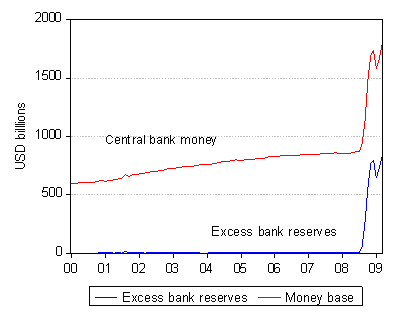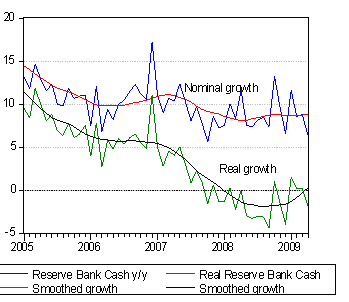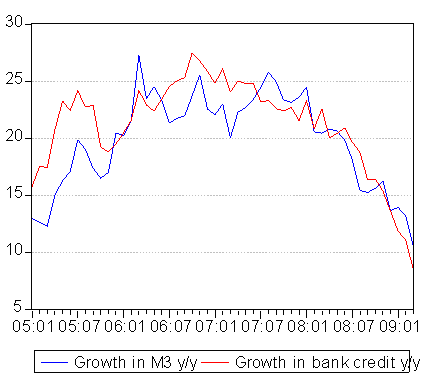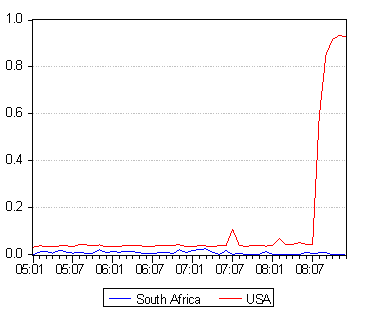Presentation to Economic Society of South Africa
Biennial Conference, Sept 8th 2009
Brian Kantor,
Professor Emeritus, University of Cape Town, Investment Strategist, Investec Private Client Securities.
Please treat this as a preliminary draft to accompany the Power Point Presentation made to the conference. A version complete with figures and tables properly integrated will be made available for public comment on my blog after the conference.
http://zaeconomist.wordpress.com/
This study demonstrates the role global capital markets play in determining the behaviour of the Johannesburg Stock Exchange (JSE Alsi) the Rand US dollar exchange rate (ZAR) and long term interest rates in South Africa on a daily basis (Albi or R157). It will be shown that since 2005 the state of global equity markets, represented in the study by the MSCI Emerging Market Index (EM) has had a very powerful influence on the JSE, a less powerful yet statistically significant influence on the ZAR and that the ZAR has had some consistent influence on the direction of long term interest rates in South Africa.
The EM may be regarded as a proxy for conditions in global capital markets that affect South Africa. JSE listed shares are included in the EM Index with a current weight of about 7%. The more abundant the capital available for emerging market capital raisers, that is to say the less risk aversion prevailing, the higher would be the level of the EM Index – and of course vice versa.
It will be shown moreover that movements in policy influenced short term interest rates, represented by daily changes in expected short term interest rates, represented by daily movements in the implicit JIBAR 3 month forward rate (Jib3f3) have had very little predictable influence on share prices, the ZAR or long term bond yields. Changes in the forward JIBAR rate are used as our proxy for short term interest rates on the presumption that it is interest rates expected, rather than current actual interest rates that drive the value of shares, bonds and currencies and that therefore changes in expected short term rates rather than changes in actual rates- that may well have been anticipated – have significance for the financial markets.1
The implications of this finding for monetary policy are surely serious ones. It would strongly suggest that policy determined adjustments to short term interest rates, when unexpected, because they do not influence the exchange rate in any consistent way, cannot therefore be regarded as a reliable anti-inflationary tool. We will attempt to explain why higher short term rates have not generally added rand strength and why lower interest rates have not meant rand weakness. The feed back effect of the exchange rate on import export and domestic prices is clearly a very important influence on the measured rate of inflation.
The case for interest rate changes as the principle instrument of monetary policy is furthermore not enhanced by the evidence that short term interest rates have not had any consistently important influence on the direction of long term interest rates in South Africa nor on the direction of share prices. However it would seem to be the case that movements in actual short term interest rates can have a significant influence on aggregate demand in South Africa and perhaps also on house prices. These relationships are not tested here and daily data would not be readily useful in such tests.
This study utilises daily data to model and estimate the behaviour of the JSE All Share Index (ALSI) the rand/USD exchange rate (ZAR) and the RSA bond index or long dated RSA bond yields (ALBI or R157) between January 1st 2005 and August 31st 2009 . The models are single equation models of daily percentage movements in the ALSI, the ZAR and the ALBI or of daily changes in long term interest rates in the case of the R157 The estimation method is single equation least squares regression analysis.2 A few additional equations using monthly data, going back to 1995 in some instances, were run for evidence of structural change in the economy.
The explanatory variables considered for inclusion in the models in addition to the movements in forward short term interest rates (JIB3f3) and the emerging markets (EM) are daily moves in the S&P 500 Index representing share prices in New York, The daily percentage movements in global commodity prices in USD (CRB) the daily moves in Australian/USD exchange rate (AUD) or AUS$) and the changes in US long dated 10 year treasury Bonds.
The character of the dependent variables is demonstrated in figures three to six. We compare the performance of the rand to both the USD and the AUD to indicate that the rand lost significant ground against what may be considered other commodity and emerging market currencies in 2006 as the USD weakened against most currencies in 2006 – 2007.
The exogenous variables of the modelling exercise are shown in figures 9 to 12. It may be seen that daily changes in the variables are highly random and that they have drifted both higher and lower since 2005. We also measure the volatility of the variables in the form of a 30 day moving average of their Standard Deviations. It is shown how much more generally volatile price and interest rate became during the financial crisis and also how similar has been the behaviour of volatility on the different markets. That risks appear so similar in the different markets is further evidence of the globalisation of capital markets. ( See figures 7, 13, 14, 15 and 16)
The increase in the volatility of share prices globally, including on the JSE , has had a very negative impact on share prices. The negative correlation between daily percentage moves in the Index of Implied Volatility on the S&P 500, the Vix and daily moves in the S&P 500 itself has been a high negative (-0.76) and between daily moves on the JSE and the SAVI an almost equally negative (-0.73) since May 2005.
Statistics for the SAVI, the implied volatility indicator of the JSE, are only available since then. It is surely volatility that drives the share market up and down. It is a much more difficult task to explain and predict volatility. Volatility in share markets may be regarded as abnormally high before 2007 when the global glut of capital was holding down interest rates and encouraging risk tolerance. The financial crisis as we well know reversed all this and produced much higher degrees of risk aversion and volatility as the likelihood of defaults and bankruptcies increased so dramatically, especially after the failure of Lehman Bros in September 2008. (See figure 17)
In figures 18 and 19 we present two tables of simple correlation statistics for the daily percentage movements in the dependent and independent variables of our models. The correlation statistics that we regard as of particular interest are highlighted in red. The correlation statistics provide essential support for the statements made earlier. To be noticed are the high correlation between the JSE in rands and the EM in USD (0.73) The correlation of the JSE with the CRB also in USD is lower but significantly positive (0.39) Daily movements in the JSE and the ZAR have been negatively correlated (-0.33) indicating that rand strength rather than rand weakness is generally helpful to the JSE.
Also to be noted is the very low almost zero correlation of daily moves in the JSE with changes in forward short term interest rates (- 0.07) The correlation of movements in the share and all bond indexes is a low but correctly signed (0.19) Lower or higher interest rates generally would not appear to have been especially helpful or harmful to the JSE over this period.
The high correlation between the AUD and the JSE does not have any obvious theoretical explanation and this must be attributed to the high correlation between the AUD with the EM Index (-0.64) shown in the following table. Clearly the global economic forces that drive the EM higher or lower strengthen or weaken the AUD/USD.
It should be noticed that the returns on the ALBI the All Bond Index (the higher the index the lower are interest rates) have been negatively correlated with the moves in the ZAR(-0.34). That is a weaker rand is associated with higher long term rates- presumably because a weaker rand is associated with more inflation to come. Of further interest is that bond market returns have been only weekly correlated with movements in short rates (-0.16). The correlation, not reported in the tables, between long dated R157 yields and these short rates is a very similar (0.16).
The high correlations over (0.50) between movements in the ZAR and the global equity markets should be noted as should the positive correlation between moves in the ZAR and the CRB and AUD. He rand has behaved as an emerging equity market and commodity currency. The weak, near zero correlation, between the ZAR and short term interest rates should be of particularly concern (.06). The final column of low correlations between short term interest rates and the equity bond and currency markets indicates how little short term interest rate moves seem to matter for the markets generally.
The regression equations reported indicate that we are able to find very good estimates for daily moves in the JSE relying on the strength of the EM effect. We back up the models of daily movements in the JSE with models of monthly movements that go back further. These monthly models confirm the growing influence of emerging equity markets on the JSE since 2003.
Our models of the rand may be regarded as very satisfactory with explanations of daily moves with the EM again providing the major impetus for the rand. Our models of monthly movements in the ZAR indicate that the EM influence has also become stronger providing for much better fits for the models in recent years.
The regression estimates for the bond market confirm the observations made before. The most consistent influence on changes in long term interest rates are movements in the ZAR. Movements in the ZAR are negatively related to moves in interest rates in an apparently statistically significant way – the weaker the rand the higher are interest rates. However the sign on the ZAR co-efficient on interest rates is reversed as the ZAR is made orthogonal to the EM influence on the ZAR. In other words the EM influence on the ZAR is first extracted to leave a pure net of EM ZAR.
The goodness of fit of the bond market model is poor though the influence of short term interest rate surprises on long term rates, while of small impact, is statistically significant. The influence of US bond yields on RSA yields is also small but also of statistical significance. Clearly other forces – especially inflationary expectations are at work in the bond market.
It must be asked why the global capital markets have become much more important for the JSE and the ZAR in recent years. The answer must lie in the structural change that occurred in South Africa after 2003 as growth in household consumption spending picked up strongly to drive the growth rates higher. This faster sustained growth was made possible by attracting foreign capital on a scale not earlier available to South Africa- at least not since the early eighties as we show in figures 38 to 40. The ability to attract capital to finance growth in SA needs to be fully taken account of when setting interest rates. The feed back loop from faster growth to more foreign capital provided needs to be well understood and nurtured. It offers the rare opportunity to achieve faster growth with less rather than more inflation.
Higher short term interest rates in SA may attract capital through the attractions of a higher carry. They appear just as likely to frighten capital away if higher interest rates are assumed to threaten the growth prospects of the economy. If so higher policy determined interest rates are as likely to bring a weaker rand and more inflation than the opposite. Higher interest rates are however very likely to slow down growth. The instrument of short term interest used to manage inflation in SA appears to have been particularly blunt and potentially dangerous to the health of the economy as they appear to have been lately.


































 Source; Federal Reserve Bank of St Louis and Investec Securities
Source; Federal Reserve Bank of St Louis and Investec Securities






